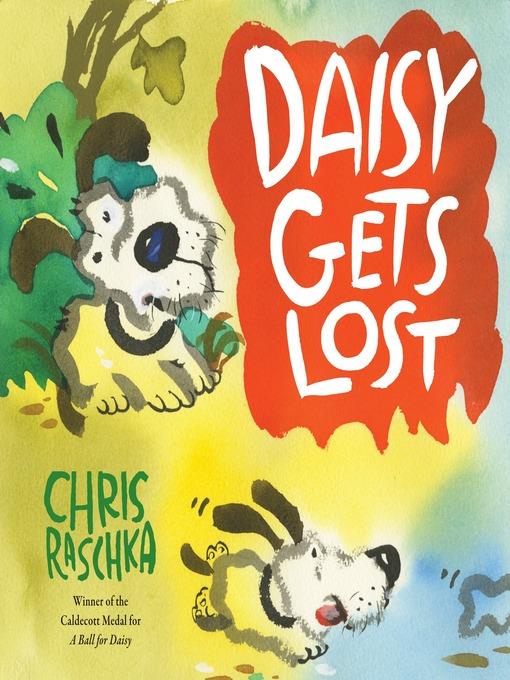
Daisy Gets Lost
کتاب های مرتبط
- اطلاعات
- نقد و بررسی
- دیدگاه کاربران
نقد و بررسی

Starred review from August 26, 2013
Another toy ball—a blue one, this time—sets in motion the events in this emotionally incisive companion to Raschka’s Caldecott-winning A Ball for Daisy. A game of fetch leads to a squirrel chase, which leaves Daisy lost and alone in the forest. Raschka again demonstrates his gift for visually capturing a sweeping range of feeling and emotion, from the gleam in the squirrel’s eye to Daisy’s wide-eyed alarm as she realizes her predicament. Raschka is sparing in his use of words—there are a couple anguished cries of “Daisy!” on the part of the dog’s young owner, as well as a mournful howl that brings about a resoundingly comforting reunion. Ages 3–7. Agent: Brenda Bowen, Sanford J. Greenburger Associates.

September 1, 2013
PreS-Gr 2-The lovable pup from A Ball for Daisy (Random, 2011) is back. Nearly wordless like its predecessor, this evocative story depicts another misadventure in the park. While playing fetch with her human and her new blue ball, Daisy sees a squirrel. In typical doggie fashion, she merrily chases the critter into the woods and gets lost. Frantic, she howls and looks for the child while the youngster searches for her. The two find each other in the end, though Daisy is still eyeing that pesky squirrel. A clever mix of layouts-mostly full spreads, occasionally changing to two to eight panels across two pages-propels the action. As in his previous work, Raschka masterfully imbues his ink, watercolor, and gouache illustrations with a stunning range of emotions. With a few brushstrokes, he captures the excitement in the lolling canine tongue, the alarm and anguish of being lost, the relief and joy of the cozy reunion. Whether a cautionary tale or one familiar to any pet owner, this book is a must for Daisy fans everywhere.-Yelena Alekseyeva-Popova, formerly at Chappaqua Library, NY
Copyright 2013 School Library Journal, LLC Used with permission.

August 15, 2013
The floppy-eared charmer who won the hearts of (among others) a Caldecott Award committee in her first outing suffers more doggy distress in this return. Having chased first her blue ball and then an amusingly unconcerned-looking squirrel, Daisy finds herself alone in the trackless woods. Applying paint with broad brushwork both wet and dry, Raschka expertly captures sweeping emotional arcs as Daisy and her equally anxious owner search for each other through dense foliage. Finally, Daisy's despairing howl leads to a reunion so joyful that it requires three nearly identical scenes to express properly. With only Daisy's called-out name and that howl for text, the pictures chart the eventful outing in a mix of full spreads and sequential strips or panels--with a midcourse aerial view that reassuringly reveals that the two are never very far apart. The duckling Daisy in Jane Simmons' Come Along, Daisy! (1998) may be more venturesome, but young children will readily identify with the mix of high spirits and vulnerability this Daisy, literally and figuratively fetching, displays. Endearing. (Picture book. 3-5)
COPYRIGHT(2013) Kirkus Reviews, ALL RIGHTS RESERVED.

September 1, 2013
Preschool-K Dogs this lovable don't stay away for long. Daisy, fresh off of her Caldecott (though, happily, it hasn't gone to her head), is back chasing balls with doggy abandon. Great funbut wouldn't chasing that squirrel be even funner? Raschka's thick, almost abstract illustrations really come to life once Daisy is lost in the forest. Soakings of watercolor approximate the sun as it is colored and diffused through branches and leaves, while finer strokes in the foreground communicate thorns and brush. It's the big, scary woods as seen by a child (or a dog), and when Raschka pulls back for a bird's-eye view of little Daisy isolated among the all-encompassing green, it's emotive rather than realistic, and all the stronger for it. As before, the alternation between full-bleed pages and smaller panels is effective, with each approach bringing with it a different emotional punch. The story? Well, there isn't one, but kids will like it that way. The tongue-flapping joy of the found dog makes plenty of good, heartfelt sense all on its own. HIGH-DEMAND BACKSTORY: That tag around Daisy's neck is a Caldecott Medal, which means this is one dog every library is going to want to bring home.(Reprinted with permission of Booklist, copyright 2013, American Library Association.)

























دیدگاه کاربران